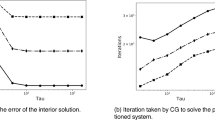Abstract
In this paper we show that the quasi-symmetric coupling of finite and boundary elements of Bielak and MacCamy can be freed of two very restricting hypotheses that appeared in the original paper: the coupling boundary can be taken polygonal/polyhedral and coupling can be done using the normal stress instead of the pseudostress. We will do this by first considering a model problem associated to the Yukawa equation, where we prove how compactness arguments can be avoided to show stability of Galerkin discretizations of a coupled system in the style of Bielak–MacCamy’s. We also show how discretization properties are robust in the continuation parameter that appears in the formulation. This analysis is carried out using a new and very simplified proof of the ellipticity of the Johnson–Nédélec BEM–FEM coupling operator. Finally, we show how to apply the techniques that we have fully developed in the model problem to the linear elasticity system.
Similar content being viewed by others
References
Bielak J., MacCamy R.C.: Symmetric finite element and boundary integral coupling methods for fluid–solid interaction. Q. Appl. Math. 49, 107–119 (1991)
Brezzi F., Johnson C.: On the coupling of boundary integral and finite element methods. Calcolo 16, 189–201 (1979)
Brezzi, F., Johnson, C., Nédélec, J.C.: On the coupling of boundary integral and finite element methods. In: Proceedings of the Fourth Symposium on Basic Problems of Numerical Mathematics (Plezň, 1978), pp. 103–114. Charles University, Prague (1978)
Carstensen C., Funken S.: Coupling of nonconforming finite elements and boundary elements. I. A priori estimates. Computing 62, 229–241 (1999)
Carstensen C., Funken C.: Coupling of mixed finite elements and boundary elements. IMA J. Numer. Anal. 20, 461–480 (2000)
Cockburn, B., Sayas, F.-J.: Symmetric coupling of boundary element and discontinuous Galerkin methods: algorithms and examples (submitted)
Costabel, M.: Symmetric methods for the coupling of finite elements boundary elements. In: Boundary Elements IX, vol. 1 (Stuttgart, 1987), pp. 411–420. Comput. Mech., Southampton (1987)
Costabel M.: Boundary integral operators on Lipschitz domains: elementary results. SIAM J. Math. Anal. 19, 613–626 (1988)
Gatica, G.N., Hsiao, G.C.: Boundary-field equation methods for a class of nonlinear problems. In: Pitman Research Notes in Mathematics Series, vol. 331. Longman, Harlow (1995)
Han H.: A new class of variational formulations for the coupling finite and boundary element methods. J. Comp. Math. 8, 223–232 (1990)
Hsiao, G.C.: Some recent developments on the coupling of finite element and boundary element methods. Numerical methods in applied science and industry (Torino, 1990). Rend. Sem. Mat. Univ. Politec. Torino 1991, Special Issue, pp. 95–111 (1992)
Hsiao G.C., Wendland W.L.: A finite element method for some integral equations of the first kind. J. Math. Anal. Appl. 58, 449–481 (1977)
Hsiao, G.C., Wendland, W.L.: Boundary integral equations. In: Applied Mathematical Sciences, vol. 164. Springer, Berlin (2008)
Johnson C., Nédélec J.C.: On the coupling of boundary integral and finite element methods. Math. Comp. 35, 1063–1079 (1980)
Kress, R.: Linear integral equations. In: Applied Mathematical Sciences, 2nd edn., vol. 82 Springer, New York (1999)
Laliena A., Sayas F.-J.: Theoretical aspects of the application of convolution quadrature to scattering of acoustic waves. Numer. Math. 112, 637–678 (2009)
McLean W.: Strongly Elliptic Systems and Boundary Integral Equations. Cambridge University Press, Cambridge (2000)
Meddahi S., Valdés J., Menéndez O., Pérez P.: On the coupling of boundary integral and mixed finite element methods. J. Comput. Appl. Math. 69, 113–124 (1996)
Meddahi S., Sayas F.-J., Selgás V.: Non-symmetric coupling of BEM and mixed FEM on polyhedral interfaces. Math. Comput. 80, 43–68 (2011)
Nédélec, J.C.: Acoustic and electromagnetic equations. Integral representations for harmonic problems. In: Applied Mathematical Sciences, vol. 144. Springer, New York (2001)
Nédélec J.C., Planchard J.: Une méthode variationnelle d’éléments finis pour la résolution numérique d’un problème extérieur dans R 3. Rev. Française Automat. Informat. Recherche Opérationnelle 7, 105–129 (1973)
Sayas F.-J.: The validity of Johnson–Nédélec’s BEM–FEM coupling on polygonal interfaces. SIAM J. Numer. Anal. 47, 3451–3463 (2009)
Steinbach, O.: A note on the one-equation coupling of finite and boundary elements. SIAM J. Numer. Anal. (in press)
Zienkiewicz, O.C., Kelly, D.W., Bettess, P.: Marriage à la mode – the best of both worlds (finite elements and boundary integrals). Energy methods in finite element analysis, pp. 81–107. Wiley, Chichester (1979)
Author information
Authors and Affiliations
Corresponding author
Additional information
G. N. Gatica’s research was partially supported by FONDAP and BASAL projects CMM, Universidad de Chile and CI2MA.
F.-J. Sayas’s research was partially supported by Spanish MEC Project MTM2007-63204 and Gobierno de Aragón (Grupo Consolidado PDIE).
Rights and permissions
About this article
Cite this article
Gatica, G.N., Hsiao, G.C. & Sayas, FJ. Relaxing the hypotheses of Bielak–MacCamy’s BEM–FEM coupling. Numer. Math. 120, 465–487 (2012). https://doi.org/10.1007/s00211-011-0414-z
Received:
Revised:
Published:
Issue Date:
DOI: https://doi.org/10.1007/s00211-011-0414-z



